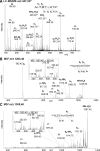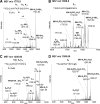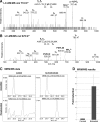Systematic mapping of posttranslational modifications in human estrogen receptor-alpha with emphasis on novel phosphorylation sites
- PMID: 18984578
- PMCID: PMC2649810
- DOI: 10.1074/mcp.M800282-MCP200
Systematic mapping of posttranslational modifications in human estrogen receptor-alpha with emphasis on novel phosphorylation sites
Abstract
A systematic study of posttranslational modifications of the estrogen receptor isolated from the MCF-7 human breast cancer cell line is reported. Proteolysis with multiple enzymes, mass spectrometry, and tandem mass spectrometry achieved very high sequence coverage for the full-length 66-kDa endogenous protein from estradiol-treated cell cultures. Nine phosphorylated serine residues were identified, three of which were previously unreported and none of which were previously observed by mass spectrometry by any other laboratory. Two additional modified serine residues were identified in recombinant protein, one previously reported but not observed here in endogenous protein and the other previously unknown. Although major emphasis was placed on identifying new phosphorylation sites, N-terminal loss of methionine accompanied by amino acetylation and a lysine side chain acetylation (or possibly trimethylation) were also detected. The use of both HPLC-ESI and MALDI interfaced to different mass analyzers gave higher sequence coverage and identified more sites than could be achieved by either method alone. The estrogen receptor is critical in the development and progression of breast cancer. One previously unreported phosphorylation site identified here was shown to be strongly dependent on estradiol, confirming its potential significance to breast cancer. Greater knowledge of this array of posttranslational modifications of estrogen receptor, particularly phosphorylation, will increase our understanding of the processes that lead to estradiol-induced activation of this protein and may aid the development of therapeutic strategies for management of hormone-dependent breast cancer.
Figures









Similar articles
-
Posttranslational modifications in lens fiber connexins identified by off-line-HPLC MALDI-quadrupole time-of-flight mass spectrometry.Invest Ophthalmol Vis Sci. 2008 Apr;49(4):1553-62. doi: 10.1167/iovs.07-1193. Invest Ophthalmol Vis Sci. 2008. PMID: 18385075
-
Evidence for phosphorylation of serine 753 in CFTR using a novel metal-ion affinity resin and matrix-assisted laser desorption mass spectrometry.Protein Sci. 1997 Nov;6(11):2436-45. doi: 10.1002/pro.5560061117. Protein Sci. 1997. PMID: 9385646 Free PMC article.
-
A novel serine phosphorylation site detected in the N-terminal domain of estrogen receptor isolated from human breast cancer cells.J Am Soc Mass Spectrom. 2008 May;19(5):729-40. doi: 10.1016/j.jasms.2008.02.008. Epub 2008 Mar 4. J Am Soc Mass Spectrom. 2008. PMID: 18367407 Free PMC article.
-
Mapping sites of O-GlcNAc modification using affinity tags for serine and threonine post-translational modifications.Mol Cell Proteomics. 2002 Oct;1(10):791-804. doi: 10.1074/mcp.m200048-mcp200. Mol Cell Proteomics. 2002. PMID: 12438562
-
Protein posttranslational modifications: phosphorylation site analysis using mass spectrometry.Methods Biochem Anal. 2005;45:85-106. Methods Biochem Anal. 2005. PMID: 19235292 Review. No abstract available.
Cited by
-
Ligand binding promotes CDK-dependent phosphorylation of ER-alpha on hinge serine 294 but inhibits ligand-independent phosphorylation of serine 305.Mol Cancer Res. 2012 Aug;10(8):1120-32. doi: 10.1158/1541-7786.MCR-12-0099. Epub 2012 Jun 5. Mol Cancer Res. 2012. PMID: 22669764 Free PMC article.
-
Decoding the PTM-switchboard of Notch.Biochim Biophys Acta Mol Cell Res. 2019 Dec;1866(12):118507. doi: 10.1016/j.bbamcr.2019.07.002. Epub 2019 Jul 11. Biochim Biophys Acta Mol Cell Res. 2019. PMID: 31301363 Free PMC article. Review.
-
Decoding estrogen receptor and GPER biology: structural insights and therapeutic advances in ERα-positive breast cancer.Front Oncol. 2025 Jun 26;15:1513225. doi: 10.3389/fonc.2025.1513225. eCollection 2025. Front Oncol. 2025. PMID: 40641933 Free PMC article. Review.
-
Proteomics-Based Identification of Dysregulated Proteins in Breast Cancer.Proteomes. 2022 Oct 21;10(4):35. doi: 10.3390/proteomes10040035. Proteomes. 2022. PMID: 36278695 Free PMC article. Review.
-
pRb controls estrogen receptor alpha protein stability and activity.Oncotarget. 2013 Jun;4(6):875-83. doi: 10.18632/oncotarget.1036. Oncotarget. 2013. PMID: 23900261 Free PMC article.
References
-
- Ciocca, D. R., and Fanelli, M. A. ( 1997) Estrogen receptors and cell proliferation in breast cancer. Trends Endocrinol. Metab. 8, 313–321 - PubMed
-
- Kuske, B., Naughton, C., Moore, K., MacLeod, K. G., Miller, W. R., Clarke, R., Langdon, S. P., and Cameron, D. A. ( 2006) Endocrine therapy resistance can be associated with high estrogen receptor α (ERα) expression and reduced ERα phosphorylation in breast cancer models. Endocr.-Relat. Cancer 13, 1121–1133 - PubMed
-
- Hoffmann, J., Bohlmann, R., Heinrich, N., Hofmeister, H., Kroll, J., Kunzer, H., Lichtner, R. B., Nishino, Y., Parczyk, K., Sauer, G., Gieschen, H., Ulbrich, H.-F., and Schneider, M. R. ( 2004) Characterization of new estrogen receptor destabilizing compounds: effects on estrogen-sensitive and tamoxifen-resistant breast cancer. J. Natl. Cancer Inst. 96, 210–218 - PubMed
-
- Howell, S. J., Johnston, S. R. D., and Howell, A. ( 2004) The use of selective estrogen receptor modulators and selective estrogen receptor down-regulators in breast cancer. Best Pract. Res. Clin. Endocrinol. Metab. 18, 47–66 - PubMed
Publication types
MeSH terms
Substances
Grants and funding
LinkOut - more resources
Full Text Sources
Other Literature Sources
Molecular Biology Databases
Miscellaneous

